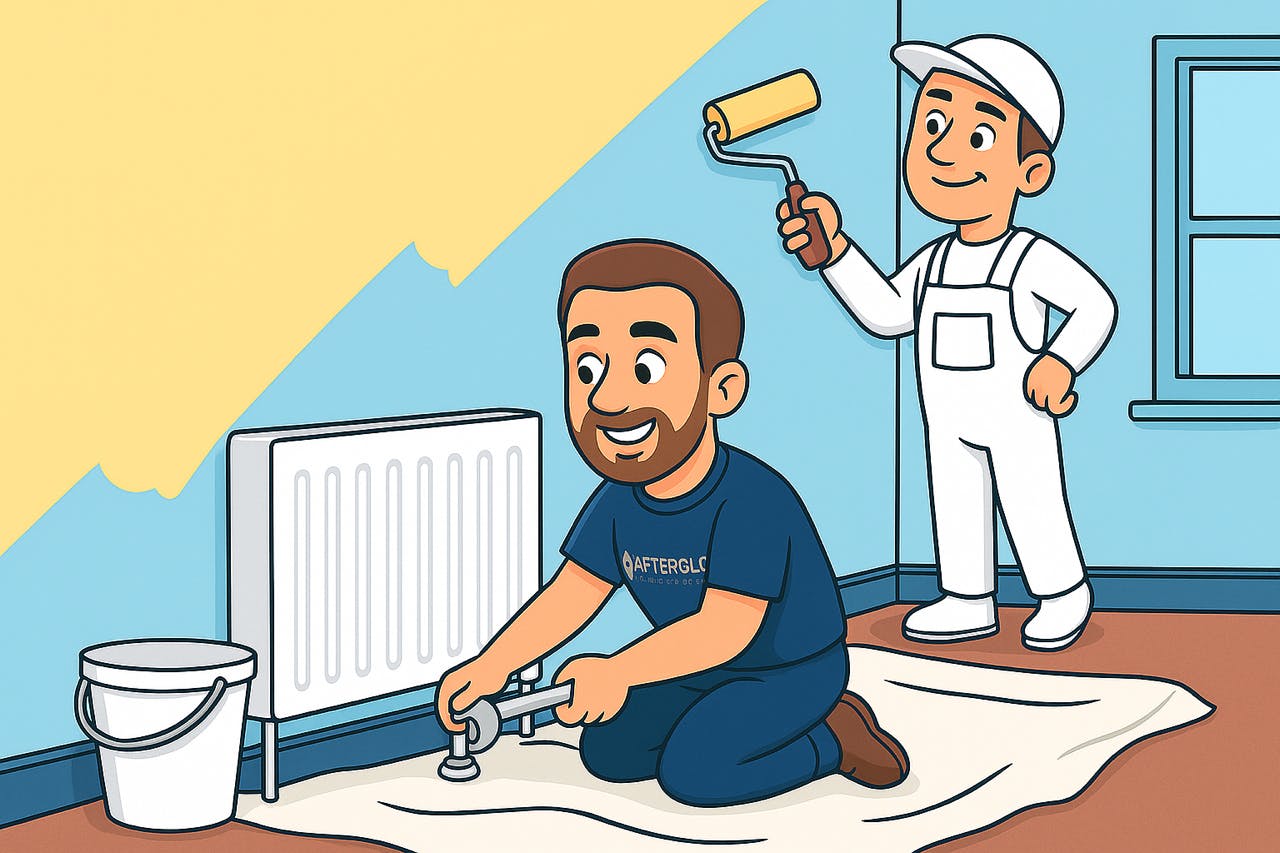How to Safely Remove a Radiator for Decorating (and When to Call the Pros)
Thinking of taking a radiator off the wall so you can get a flawless paint or wallpaper finish? It’s doable as a DIY job, but be warned: radiators are full of murky “black sludge” (magnetite) that will happily stain carpets and walls. Removing one incorrectly can also introduce air into your heating system, cause leaks, or leave you with a cold house if you can’t get it bled and balanced afterwards.
If you’d rather avoid the mess and stress, Afterglow Plumbing & Heating are professional plumbing and heating engineers in Birmingham and Solihull. We’ll protect your home, properly isolate the system, and dispose of waste water safely—minimising the risk of black sludge on carpets or walls. We also offer emergency plumbers in Birmingham if you’ve started and hit a snag.

Where we work
We cover Birmingham (City Centre, Edgbaston, Harborne, Moseley, Kings Heath, Selly Oak, Bournville, Erdington, Sutton Coldfield, Perry Barr, Hall Green, Yardley, Northfield) and Solihull (Shirley, Olton, Monkspath, Elmdon, Knowle, Dorridge, Hockley Heath, Bentley Heath, Balsall Common, Meriden, Castle Bromwich, Chelmsley Wood, Smith’s Wood).
Searching for “plumbing and heating engineers near me in Birmingham” or “emergency plumbers in Birmingham for leaking radiator”? You’re in the right place.
Before you start: important safety
- Turn the heating and boiler off and let everything cool completely.
- Is it a sealed (pressurised) system? If you have a combi or system boiler with a pressure gauge, it’s sealed. Note the current pressure (usually ~1.0–1.5 bar when cold).
- Protect floors and walls with dust sheets and plastic. Have towels, a large tray/bucket, and old rags ready.
- Use the right caps: A thermostatic radiator valve (TRV) can still allow flow on “frost” mode. Fit a decorator’s cap (a solid blanking cap) to shut it off completely, or fully close a manual valve.
- Count your turns: On the lockshield valve (the one with a small plastic cap), note how many turns to shut so you can restore balance later.
- If anything looks corroded, seized, or you’re unsure—call Afterglow. A snapped union or stuck valve quickly becomes an emergency.
Tools & materials
Radiator key, adjustable spanners, grips, towels, large tray/bucket, PTFE tape, decorator’s cap for TRV, blanking plugs (optional), hosepipe & jubilee clip (for drain-off), small container for bleed water, gloves.
Two ways to approach the job
You can usually remove a single radiator without draining the whole system, which is quicker and less disruptive. Alternatively, you can drain the system via a drain-off valve (helpful if you plan to remove multiple radiators or do other work).
Method A: Remove one radiator without draining the whole system
- Shut both valves
- TRV/manual valve: turn fully clockwise to close. Fit a decorator’s cap if it’s a TRV.
- Lockshield: pop off the cap and turn clockwise to close. Count the turns (e.g., “1½ turns”) for later.
- Open the bleed screw (top end)
Use a radiator key to crack it slightly. This releases residual pressure. - Place a tray under the valve unions
Put towels behind the pipe and against the skirting. - Loosen the union nut on the TRV side
Use one spanner to hold the valve body steady and another to loosen the union nut that joins valve to radiator tail. Expect water and black sludge—catch it in the tray. - Loosen the union on the lockshield side
Let the radiator drain into the tray. Tilt the radiator slightly towards the open side to encourage flow. - Remove and cap
Once the radiator is light and mostly empty, lift it straight up off the brackets and carry it outside or to a safe area to drain fully. You can temporarily fit blanking caps on the open radiator tails if you like, but the valves are shut, so no system water should leak.
Plug the open valve ends (optional but tidy)
A bit of PTFE on the radiator tails or dedicated blanking plugs helps avoid drips while decorating.
What does a drain-off valve look like?
A drain-off valve is a small brass fitting with:
- A hose tail or nozzle to push a hosepipe onto.
- A square, slotted, or small screw head to open/close it.
It’s usually fitted: - On pipework near a downstairs radiator (often the lowest point),
- Near the boiler or airing cupboard,
- Occasionally on an outside wall or low copper tail.
You’ll often see a short stub of copper with the brass valve attached.
Steps to drain down
- Turn boiler & electrics off, let the system cool.
- Attach a hosepipe to the drain-off and secure with a jubilee clip. Route the hose to a foul drain at ground level.
- Open the drain-off a turn or two. Water should start flowing.
- Let air in so water can leave
Go to the highest radiators first and open their bleed screws a quarter turn. Work down through the house. This “vents” the system so it drains fully. - Wait until flow stops at the hose. Close all bleed screws, then close the drain-off.
Now follow Method A, steps 4–6 to remove the radiator(s), but you’ll find a lot less water remains in the panels and pipe tails.
Re-fitting after decorating
- Hang the radiator back on its brackets.
- Reconnect unions on TRV/manual and lockshield sides. Use fresh PTFE on the male tails if needed. Nip up—don’t overtighten.
- Close the radiator bleed screw (hand tight with the key).
If you removed only one radiator (no full drain)
- Re-open the valves
- Open the lockshield by the exact number of turns you noted earlier.
- Open the TRV/manual valve.
- Bleed the radiator
Crack the bleed screw until air stops and water flows steadily; close it. Check for leaks at the unions.
If you drained the whole system
- Refill the system
- Sealed systems (combi/system boiler): Open the filling loop slowly and let pressure rise to ~1.0–1.5 bar (cold). Close the loop.
- Open-vented systems: Untie the ball valve or re-open the feed to the F&E tank so it tops up.
- Add inhibitor if you drained a lot of water—this protects against future sludge.
- Bleed radiators in order
- Start upstairs/highest radiators, then move downstairs.
- On a sealed system, keep an eye on the pressure; top back to 1.0–1.5 bar as it drops during bleeding.
- Bleed each radiator until a steady stream of water appears.
- Power on and test
Turn the boiler and heating on. Check for hot flow across all radiators. Re-bleed any cool tops. - Balance if needed
If some rooms overheat and others lag, slightly throttle lockshields on the hottest radiators to balance flow.
Common pitfalls (and quick fixes)
- TRV still letting by: Fit a decorator’s cap; the numbered head doesn’t always fully shut.
- Black sludge everywhere: Use big trays, towels, and open unions gradually. If you’ve had a spill, we can help clean and flush.
- Can’t find the drain-off: Look at the lowest pipe runs near back doors, kitchens, or under the boiler. It’s that small brass piece with a hose connection.
- No water when refilling / frequent airlocks: Check that the filling loop valves are open, then closed at target pressure. Bleed highest points first.
- Leaking unions after refit: Back off, re-seat, add PTFE, and re-tighten gently while supporting the valve body.
- Boiler locks out after refill: You may have trapped air in the boiler or pumps. Bleed again and ensure system pressure is correct. If it persists, call Afterglow emergency plumbers in Birmingham.
Upgrade option: don’t put tired rads back
Freshly decorated room? Consider replacing old radiators with modern, efficient panels or vertical designer radiators. Benefits:
- Better heat output for the same wall space.
- Cleaner internals = less sludge and improved efficiency.
- Smart TRVs and properly sized rads can lower bills.
We can specify, supply, and fit replacements across Birmingham and Solihull.
While we’re there: get the boiler serviced
Hiring a professional anyway? Why not get the boiler serviced at the same time as removing or reinstalling radiators. A service by a Gas Safe registered engineer in Birmingham can:
- Check combustion and flue safety,
- Optimise efficiency,
- Clean magnetic filters and top up inhibitor,
- Spot early faults before winter.
When to call Afterglow Plumbing & Heating
- You want zero-mess radiator removal for decorating.
- You’ve started the job and hit a problem (stuck valves, no drain-off, leaks, no heat after refill).
- You prefer a professional finish and system left bled, balanced, and protected with inhibitor.
- You’d like emergency plumbers in Birmingham today.
- You want new radiators specced and installed, or a boiler service while we’re onsite.
Final word
DIY radiator removal is possible, but the risk of black sludge leaks, damaged valves, and refilling issues is real. If you want it done quickly and cleanly—book Afterglow Plumbing & Heating. We work across Birmingham and Solihull (including the suburbs listed above), and we’re here for emergencies too.



